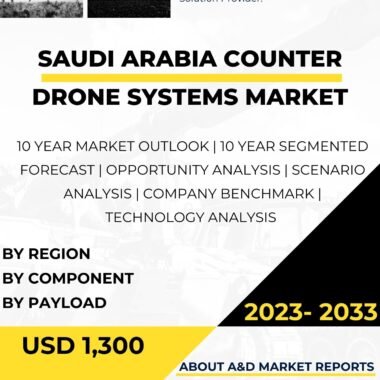Description
The counter-drone systems market in Japan has witnessed significant growth and strategic importance in recent years, driven by the nation’s focus on enhancing its defense capabilities and addressing security challenges posed by unmanned aerial systems (UAS). Counter-drone systems play a critical role in modern military and security operations, providing the ability to detect, track, and neutralize unauthorized or potentially hostile drones, thereby safeguarding critical infrastructure, public safety, and national security.
Japan’s security concerns are influenced by various factors, including the evolving global security landscape, regional tensions, and the increasing proliferation of commercial drones with potential misuse by malicious actors. As a result, Japan has been proactive in developing and deploying advanced counter-drone technologies to protect its airspace and address the emerging threat posed by drones.
One of the primary applications of counter-drone systems in Japan is in the defense sector. The Japan Self-Defense Forces (JSDF) have integrated various counter-drone systems into their operations, significantly enhancing their ability to detect and respond to unauthorized drones in sensitive areas. Counter-drone systems serve as a crucial component of the JSDF’s layered defense strategy, complementing other air defense measures to provide a comprehensive approach to countering aerial threats.
The deployment of counter-drone systems allows the JSDF to achieve increased preparedness for potential aerial threats, conduct effective surveillance and tracking of unauthorized drones, and engage hostile drones with precision, if necessary. Counter-drone systems are particularly vital for safeguarding military installations, critical infrastructure, and public events from potential drone attacks.
Moreover, Japan’s commitment to indigenous defense capabilities has driven the development of domestically produced counter-drone solutions. Japanese defense companies have been actively involved in research, development, and production of advanced counter-drone technologies tailored to Japan’s specific requirements. This collaboration between the government and the domestic defense industry fosters innovation and contributes to the growth of the domestic counter-drone systems market.
In addition to the defense sector, the counter-drone systems market in Japan is also influenced by its focus on security and public safety. As a technologically advanced nation with numerous critical infrastructure facilities and densely populated urban areas, Japan recognizes the importance of protecting these assets from potential drone threats. Counter-drone systems play a crucial role in safeguarding sensitive locations, such as airports, government buildings, nuclear facilities, and major events.
Furthermore, Japan’s commitment to international security cooperation has also driven the acquisition of specialized counter-drone technologies. The JSDF has participated in multinational military exercises and joint operations, contributing to regional security and stability. Counter-drone systems enhance the safety and effectiveness of these operations, enabling better protection for allied forces and assets.
The counter-drone systems market in Japan also benefits from its alliance with the United States. As part of its defense cooperation with the U.S., Japan has access to advanced counter-drone technologies and expertise. The U.S. has been a key supplier of counter-drone systems and related equipment to Japan. This alliance strengthens Japan’s defense capabilities and contributes to regional security and stability.
Challenges in the counter-drone systems market in Japan include addressing potential threats from rapidly evolving drone technologies, such as increased range, endurance, and autonomous capabilities. As adversaries develop more sophisticated and unpredictable drone threats, Japan must continuously upgrade its counter-drone capabilities and tactics to stay ahead of potential threats. This necessitates ongoing research and development efforts to enhance detection, tracking, and neutralization capabilities.
Moreover, ensuring the interoperability of counter-drone systems with other elements of the JSDF’s force structure is crucial for efficient and effective military operations. Standardizing equipment, communication systems, and tactics across different units and defense systems requires careful planning and coordination.
Cost considerations also influence Japan’s counter-drone systems procurement decisions. Developing and acquiring advanced counter-drone technologies can be expensive, requiring prudent budget allocation and prioritization. Japan must balance investing in cutting-edge technologies with maintaining other critical aspects of its defense capability.
In conclusion, the counter-drone systems market in Japan has seen significant growth and strategic importance, driven by the nation’s focus on enhancing its defense capabilities and addressing security challenges posed by unmanned aerial systems. Counter-drone systems play a critical role in modern military and security operations, providing the ability to detect, track, and neutralize unauthorized drones. The collaboration between the government and the domestic defense industry, as well as international partnerships with allied nations, fosters innovation and contributes to the growth of the domestic counter-drone systems market. Challenges related to emerging threats, interoperability, cost considerations, and technology development must be addressed to further enhance Japan’s counter-drone capabilities and ensure its ability to protect critical infrastructure, public safety, and national security from potential drone threats. With its strategic focus on modernizing its defense forces, Japan remains committed to leveraging advanced counter-drone technologies to enhance its capabilities in countering aerial threats and contribute to regional and global security.




